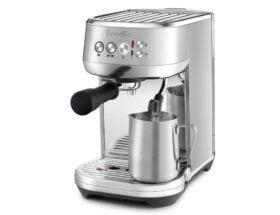
How to Adjust Coffee Strength for the Perfect Flavor
The strength of your coffee can greatly affect its taste. In this blog post, we will delve into the art of adjusting coffee strength to achieve the perfect flavor. We will explore three methods that allow you to fine-tune your brew to your liking. From adjusting the coffee-to-water ratio to selecting the right coffee beans and brewing method, we will cover everything you need to know to achieve your ideal cup of coffee. So grab your favorite mug and get ready to learn how to tune your brew for maximum enjoyment.
Table of Contents
How to Adjust Coffee Strength for the Perfect Flavor
The strength of your coffee can greatly affect its taste. Whether you prefer a bold and robust flavor or a milder and more delicate taste, being able to adjust the strength of your brew is key. In this blog post, we will explore three methods to adjust the strength of your coffee, allowing you to fine-tune your brew to your liking. From adjusting the coffee-to-water ratio to choosing the right coffee beans and brewing method, we’ve got you covered.
Method 1: Adjusting the Coffee-to-Water Ratio
The coffee-to-water ratio is one of the most critical factors in determining the strength of your coffee. A higher ratio of coffee to water will result in a stronger brew, while a lower ratio will produce a milder taste. Finding the perfect balance is a matter of personal preference, but a commonly recommended starting point is a ratio of 1:15 – that is, one part coffee to 15 parts water.
- Understanding Ratio Impact: The coffee-to-water ratio directly impacts the intensity of your coffee. A higher ratio, such as 1:15 or 1:16, yields a stronger brew with more pronounced flavors, while a lower ratio, like 1:17 or 1:18, produces a milder taste profile. It’s essential to grasp this relationship to tailor your coffee strength to your preference.
- Starting Point: While the commonly recommended starting point is a ratio of 1:15 (one part coffee to 15 parts water), this can serve as a baseline for experimentation. Begin with this ratio and adjust according to your taste preferences. Keep track of your adjustments to fine-tune your brewing process over time.
- Experimentation: To adjust the strength of your coffee, experiment with different ratios by varying the amount of coffee grounds relative to the water. For a stronger brew, increase the coffee-to-water ratio by adding more coffee grounds. Conversely, for a milder taste, decrease the ratio by reducing the amount of coffee grounds used. Be mindful that even small adjustments in ratio can significantly impact the final taste.
- Consider Brewing Variables: It’s crucial to recognize that altering the coffee-to-water ratio may necessitate adjustments in other brewing variables to maintain an optimal flavor profile. Factors such as grind size, brewing time, and water temperature should be tailored accordingly to achieve consistency and balance in your brew.
- Precision and Consistency: Achieving the perfect coffee strength requires precision and consistency in measuring both coffee and water. Investing in a reliable coffee scale ensures accuracy in your brewing process, enabling you to replicate your preferred taste profile consistently.
- Taste Testing: Regularly taste-test your brewed coffee to evaluate the results of your adjustments. Pay attention to flavor intensity, acidity, bitterness, and overall balance. This iterative process of experimentation and refinement empowers you to hone in on your ideal coffee strength.
To adjust the strength of your coffee, you can experiment with different ratios. If you prefer a stronger brew, increase the amount of coffee grounds relative to the water. Conversely, for a milder taste, reduce the amount of coffee grounds. Keep in mind that the brewing time and extraction process might need to be adjusted accordingly to maintain the optimal flavor profile.
Method 2: Choosing the Right Coffee Beans
The type of coffee beans you select can also significantly impact the strength of your brew. Different coffee beans have varying levels of acidity, bitterness, and intensity of flavors. Dark roast beans tend to result in a more robust and bold taste, while light roast beans offer a lighter and more nuanced flavor profile. Experimenting with different coffee bean varieties can help you find the perfect balance of strength and flavor.
- Origin: Coffee beans sourced from distinct regions around the world offer diverse flavor profiles due to variations in soil composition, climate, and altitude. For instance, beans from Central America often exhibit fruity and floral notes, while those from Africa tend to have vibrant acidity and fruity undertones. South American beans, on the other hand, may boast a balanced flavor with nutty or chocolatey nuances. Exploring beans from different origins allows you to discover a spectrum of flavor possibilities and find your preferred taste profile.
- Processing Method: The method used to process coffee beans after harvesting also influences their flavor profile. Common processing methods include washed, natural (dry), and honey (semi-washed) processes. Washed beans typically yield a cleaner cup with bright acidity, while natural processed beans offer a fuller body and fruit-forward flavors. Honey processed beans strike a balance between the two, often showcasing sweetness and complexity. Experimenting with beans processed through various methods allows you to tailor the strength and flavor of your brew to your liking.
- Roast Level: Coffee beans are roasted to different degrees, ranging from light to dark roast levels, each imparting distinct flavor characteristics. Light roast beans retain more of their inherent flavors from the origin, featuring pronounced acidity and floral or fruity notes. Medium roast beans strike a balance between acidity and body, offering a nuanced flavor profile with caramel or nutty undertones. Dark roast beans, on the other hand, exhibit bold and smoky flavors, with diminished acidity and increased bitterness. Consider your preference for flavor intensity and roast depth when selecting beans, as this choice significantly influences the strength and overall taste of your coffee.
- Blend vs. Single Origin: You can choose between blends, which combine beans from multiple origins to achieve a specific flavor profile, or single-origin beans, which highlight the unique characteristics of coffee from a particular region. Blends often offer consistency and balance, while single-origin beans provide an opportunity to explore the nuanced flavors of a specific terroir. Experimenting with both options allows you to refine your palate and discover your preferred flavor balance.
When choosing coffee beans, consider the origin, processing method, and roast level. Each factor can contribute to the overall taste and strength of the coffee. Don’t be afraid to explore different regions and blends to discover your preferred flavor profile.
Method 3: Exploring Different Brewing Methods
The brewing method you use can also influence the strength of your coffee. Different techniques such as pour-over, French press, espresso, or cold brew can yield varying levels of strength and flavor. Each method has its own nuances and allows for different levels of control over the brewing process.
If you prefer a stronger brew, methods like espresso or French press tend to extract more flavors from the coffee grounds. Conversely, if you enjoy a milder taste, pour-over or cold brew methods can produce a smoother and less intense cup. Experimenting with different brewing methods can help you discover new flavors and find the perfect strength for your taste buds.
French Press
The French press brewing method involves steeping coarse coffee grounds in hot water before pressing them down with a plunger to separate the grounds from the brewed coffee. To adjust the strength:
- Grind Size: Experiment with a coarser grind size for a milder flavor and a finer grind for a stronger brew. Coarser grounds will require a longer steeping time to achieve a stronger flavor.
- Steeping Time: Increase the steeping time for a stronger brew. Typically, a steeping time of 4-5 minutes is standard, but you can extend it slightly for a bolder flavor. Conversely, reducing the steeping time can result in a milder taste.
- Water Temperature: Adjust the water temperature to control the extraction process. Optimal water temperature is around 195-205°F (90-96°C), but lowering it slightly can lead to a milder brew, while increasing it can intensify the flavor.
Pour Over
Pour-over brewing involves pouring hot water over coffee grounds in a filter, allowing it to drip through into a container below. To adjust the strength:
- Grind Size: Finer grounds lead to a stronger extraction, while coarser grounds result in a milder flavor. Experiment with different grind sizes to find your preferred strength.
- Flow Rate: Adjust the flow rate of water by pouring it more slowly for stronger extraction or more quickly for a milder taste. This allows you to control the intensity of the brew.
- Water-to-Coffee Ratio: While the ratio of water to coffee is critical in all brewing methods, it’s especially important in pour-over. Experiment with different ratios to find the perfect balance for your taste preferences.
Espresso
Espresso brewing involves forcing hot water through finely-ground coffee under high pressure, resulting in a concentrated and flavorful shot. To adjust the strength:
- Grind Size: Finer grounds are typically used for espresso to maximize extraction and flavor. Adjust the grind size slightly finer for a stronger shot and coarser for a milder one.
- Extraction Time: Control the extraction time to adjust the strength of the espresso. A longer extraction time extracts more flavors and compounds from the coffee grounds, resulting in a stronger shot. Conversely, a shorter extraction time produces a milder taste.
- Tamping Pressure: The pressure applied when tamping the coffee grounds into the portafilter basket can impact extraction. Experiment with different tamping pressures to fine-tune the strength and flavor of your espresso.
By adjusting these parameters in each brewing method, you can tailor the strength of your coffee to your exact preferences, whether you prefer a bold and robust cup or a milder and more delicate flavor profile. Experimentation is key to finding the perfect balance that suits your taste buds.
Adjusting the strength of your coffee is all about finding the right balance. By experimenting with the coffee-to-water ratio, choosing the right coffee beans, and exploring different brewing methods, you can fine-tune your brew to match your preferred flavor profile.

Experimenting with Different Brewing Methods
The brewing method you use can also affect the strength of your coffee. Here are a few popular brewing methods and how they can be adjusted:
- French Press: Increase the steeping time for a stronger brew or decrease it for a milder one.
- Pour Over: Adjust the flow rate of water for more or less extraction.
- Espresso: Experiment with grind size and extraction time to fine-tune the strength.
Don’t be afraid to try out different brewing methods to find the one that yields the perfect strength for your taste buds.
Wrap Up
Adjusting the strength of your coffee is a crucial step in achieving the perfect flavor. By experimenting with the coffee-to-water ratio, selecting the right coffee beans, and utilizing different brewing methods, you can fine-tune your brew to suit your preferences.
Remember, the ideal coffee strength is subjective and may vary from person to person. Don’t be afraid to tweak the variables until you find the balance that pleases your taste buds.
We hope this brewing guide has provided valuable insights and practical tips to enhance your coffee brewing process. Whether you prefer a bold and strong cup or a milder and more delicate flavor, understanding the techniques for adjusting coffee strength will give you the power to create your perfect brew.
Don’t hesitate to leave a comment below and share your thoughts and experiences with adjusting coffee strength. We also encourage you to explore our website for more resources on different coffee brewing methods, coffee bean selection, and other informative articles.









